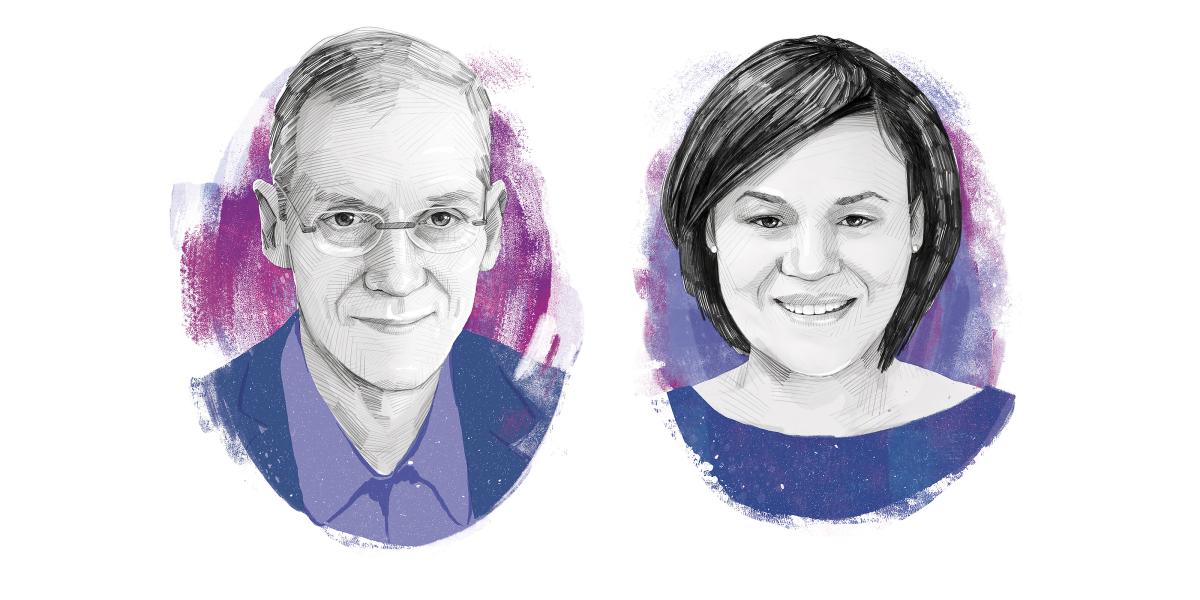The Exchange: Equity Solution
Philadelphia Health Commissioner Thomas Farley and health policy expert Keshia Pollack discuss ways to engage urban leaders in health issues.
Much of what affects the public’s health is beyond the purview of local health agencies: poverty, unemployment, education ... The solution, according to Philadelphia health commissioner Thomas Farley, MD, MPH, is to talk with public officials about the health benefits of social policies such as increasing the minimum wage. In December, Farley, who led New York City’s health department, and Keshia Pollack, PhD '06, MPH, a Health Policy and Management associate professor, discussed this and other urban health issues. The pair considered how health equity flows from equity, ways to eliminate road traffic deaths and how to create safe places for children to play outside.
KP: New York City has implemented Vision Zero, a strategy to eliminate road traffic fatalities and injuries. I’m seeing a lot of other cities interested in it.
TF: Vision Zero frames it in a way that is just very compelling to people: This is totally preventable, and nobody should have to die in a vehicle-related crash. I think it’s a great idea, and the mayor here in Philadelphia has just named a Vision Zero Task Force, which will be developing an action plan over the next few months. People are healthier if you have active transportation—walking and biking. There are reduced injuries, obviously, from crashes, but there are also effects on air pollution and on physical activity. You put those all together, and the health benefits of active transportation are huge.
"Health in all policies" in themselves don't really accomplish much. What matters is if the mayer and city council members take health into account in the decisions they make.
KP: The “Health in All Policies” concept—advancing the consideration of health in other sectors—seems to be growing at local levels.
TF: My opinions on that are probably different from many people in public health. To me, these “Health in All Policies” in themselves don’t really accomplish much. What matters is if the mayor and city council members take health into account in the decisions they make. And here, and in New York, the mayors do. They care about health. And I, as health commissioner, have access to them and can [talk] to them about the health benefits or risks of other policies. I think that that’s more important than adopting formal “Health in All Policies.”
KP: We’re seeing challenges to getting other sectors engaged in health. What are your strategies?
TF: I would just say that is the job of the lead health official. It’s recognized that much, or maybe even most, of what determines health is outside of the responsibility of the health department. And so he or she has to engage with other city agencies and with the legislative body and the chief elected official, talking about public health benefits in ways that they understand, and find out ways to align the health objectives with the objectives of other entities.
KP: We’re also seeing city health departments pushing better consideration of health equity in these decisions.
TF: To me, the way to really change health equity is to change equity. The factors that drive poor health are social factors like poverty and lack of education and unemployment. Those are definitely outside of the responsibility of the health department but are influenced by the legislative body and the mayor or governor. So I think we should engage in those issues and say, for example, “You know, there’s actually a health benefit to an increased minimum wage.” When I came to Philadelphia, there was a policy proposed that addressed health in a more traditional way and health equity at the same time. And that was the Philadelphia beverage tax. It is a tax on sugary drinks, which should be really helpful in addressing the epidemics of obesity and diabetes, problems that are preferentially hurting low-income people. Most of the revenue from that tax is going for expanded prekindergarten. And that use of the revenue was chosen explicitly by the mayor, because when he looked around he saw that the low-income families didn’t get the benefit of pre-K that high-income families did. So it was an equity solution that came about because the mayor and the city council had the right orientation, tied to a traditional health approach.
KP: Another equity issue that I think about, particularly here in Baltimore, is [ensuring] that kids in under-resourced communities have access to safe places to play. I’m a fan of New York City’s “play streets.” I’m looking at implementing “play streets” in rural communities for a recently funded project.
TF: I think the best way to implement that really varies with the land use, population density and transportation policy. In New York City, with a very high density and a shortage of other places to play, it makes a lot of sense. Here in Philadelphia, we have a number of parks and playgrounds and recreation centers, which are quite good in theory but are in much disrepair. And so another thing that was funded with the Philadelphia beverage tax is a major rebuilding effort for the parks and recreation centers and libraries too. So it’s going to vary from site to site, but I do think providing safe places to play has a huge benefit, especially where the neighborhoods are perceived by parents to be unsafe, so kids are stuck inside.
KP: Any last thoughts before we wrap up?
TF: I would end by encouraging your students and others associated with Hopkins to look at city health departments as places where the greatest innovation in public health is happening today. The federal government is stuck in partisan warfare and can’t be very effective, and states are pretty distant from what’s happening on the ground. But city health departments are very exciting places to implement innovative ideas.
